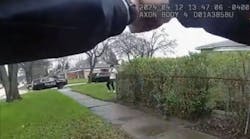Imagine going about your life in a normal way and then, without warning, and to your utter disbelief and shock, it is suddenly turned upside down and inside out with consequences that are so horrific you sometimes wonder if you would live to tell about it. That is precisely what happened to Dwayne Allen Dail who was unjustly incarcerated for 18 ½ years for crimes he did not commit.
In 1987, a 12-year-old girl in Goldsboro, North Carolina was raped. The following day a detective was knocking on Mr. Dail's door questioning him about his whereabouts on the day of the rape. Mr. Dail told the detective that he was probably asleep. After Mr. Dail returned from work to have dinner with his mother on May 13, 1988, he learned that he was charged with first-degree burglary, first-degree rape, first-degree sex offense, indecent liberties, and lewd and lascivious actions. "I was absolutely floored," says Mr. Dail, who was 19-years-old at the time. He spent 4 ½ days in jail and was released on $5,000.00 bond.
How was Mr. Dail targeted for blame in this incident? Three weeks after the rape occurred, the mother of the victim observed Dwayne drive by her home in a van and thought she saw him look up at the apartment complex and stare at the window for too long a period of time. As a result, she called the police and provided his name. Weeks later, the victim saw Mr. Dail walking and stated he was the perpetrator. In the child's mind, he became the rapist. Signs of false exposure, surrounding this accusation that pointed to Mr. Dail, included the early morning hour, the young victim, little lighting, and a short interval of exposure.
His trial began March 27, 1989. An offer was made for him to plead no contest to the misdemeanor and be placed on 3 years probation. Mr. Dail declined the offer because he knew he did nothing wrong. The charge of lewd and lascivious act was dropped before the charges went to the jury. He was subsequently convicted of first-degree burglary, first-degree rape, first-degree sex offense, and indecent liberties on March 29, 1989. On March 30, 1989, he received a sentence of two life terms plus 18 years. Mr. Dail was sent to Central Prison on March 31, 1987. "I tried not to cry," says Mr. Dail when he was taken to the first youth prison, Polk Youth Institute, and went through the orientation process. He had not been there 15 months when he was threatened and raped. Not understanding what it was, he signed himself into protective custody where he remained for several months. "It was a lot less threatening but no less terrorizing," says Mr. Dail.
While in prison, Mr. Dail wrote to numerous magazines and newspapers about his situation claiming his innocence. When he had a custody review, he was asked if he wanted to remain in protective custody, which he did, and he had to sign for this request. From Polk, he was sent to Blanch prison and placed in a single cell where he remained for eight months. "I've never been so confined in my life," says Mr. Dail. He continued his letter writing campaign. "I began reading everything I could while I was in there," says Mr. Dail. While at Blanch, he turned 21 years old.
From Blanche he was sent to Eastern Correctional Institute. In comparison to Pope and Blanch, Mr. Dail says, "It was a new building, very soothing, freshly painted, floors waxed, inmates older." He took classes there and became comfortable. "I was so deceived by the appearance of the place. I let my guard down. As a result of that, I was raped and beaten and that was just the beginning of a long road." The word was out among the prison population that Mr. Dail was a child molester and, as a consequence, he was victimized in the correctional system. "I was convicted for raping a 12-year-old Black girl, and everyone in prison knew that," says Mr. Dall.
Throughout his 18 ½ years of incarceration, he was transferred 17 times. Mr. Dail continued his letter writing campaign and wrote the governor daily about his innocence. He had read about DNA and contacted his attorney and requested a DNA test. He also noted he did not want the evidence destroyed. "I knew the power of DNA," says Mr. Dail. In 1995, his family inquired about the evidence and they were told that it had been destroyed in 1994. "I felt then that with the evidence destroyed, my life was actually over," says Mr. Dail.
Mr. Dail was informed that the Center for Project Innocence accepted his case for investigation. In 2004, the Center informed Mr. Dail there was nothing they could do for him because the evidence had been destroyed. They contacted the victim who was not interested in speaking about the matter. "We ran into so many brick walls," says Mr. Dail.
Mr. Dail and his family searched for ways he could possibly make parole. When he did receive a parole hearing, he was informed that in order for him to make parole, he would have to take a sex offender course and express remorse to the parole board. "I just could not do that," said Mr. Dail. He indicated he would have to die, but he would not admit guilt for a crime he did not commit.
One day, when he was taken to the visitation area, there stood a woman, Christine Mumma, an attorney with the North Carolina Center on Actual Innocence. Ms. Mumma informed Mr. Dail that evidence had been found in his case. "I fell out of my chair and burst into tears. Evidence meant I was going home, and I knew that," said Mr. Dail. He immediately told Ms. Mumma, "Test anything and everything you can find."
Fortunately for Mr. Dail, the evidence in his case had mistakenly been placed on a shelf where evidence in murder cases is held, and it remained there for 18 years. Consequently, the rape kit had not been destroyed. If the kit had been placed on the shelf where rape evidence was held, it would have already been destroyed. The evidence proved that semen found in the nightgown of the victim excluded Duane as the perpetrator.
The Innocence Center receives 1200 innocence claim inquiries per year with a 95% rejection rate. According to Ms. Mumma, there were several things about Mr. Dail's case that caused them to pursue it - he refused attractive offers that were made to him; he was dragged from the courtroom by his ankles while he continually proclaimed his innocence, and the evidence was weak.
Ms. Mumma explains that preservation, property collection, storage, and notice of destruction are critical elements for working cold cases and cases that involve victims of violent crimes. She emphasizes these areas must be a priority relative to investigation of such cases. "In many of these cases, it is pure luck that results in exoneration," says Ms. Mumma.
In October 2007, Mr. Dail received a pardon from North Carolina Governor Mike Easley. "It's a whole different world than in 1989. You can't imagine how stupid a person feels when you can't pump gas," says Mr. Dail. "A lot has changed in the last 20 years. My son was born seven months after I was locked up, and my mother is a little old lady now. It's difficult to get to know my family again," says Mr. Dail who acknowledges his family was always close. "They suffered immensely," he adds.
Mr. Dail is currently receiving compensation from the state of North Carolina but, most importantly, he is rejoicing in having his freedom and innocence back. "What is most important to me is that I survived. I hope to think I am on my way back. I am blessed," says Mr. Dail.
The victimization he endured was an ordeal that captured, what could have been, many productive years of his life. The dedicated efforts of Christine Mumma, a tenacious attorney who believed in his innocence, greatly assisted with this successful outcome. "I've seen other cases where I believe people were factually innocent and evidence has been destroyed. For me, this case was just a small reward for all the pain we've had on those other cases," says Ms. Mumma. She shares Mr. Dail's happiness and is unrelenting in her support. "I'm with him every step of the way," she says.



